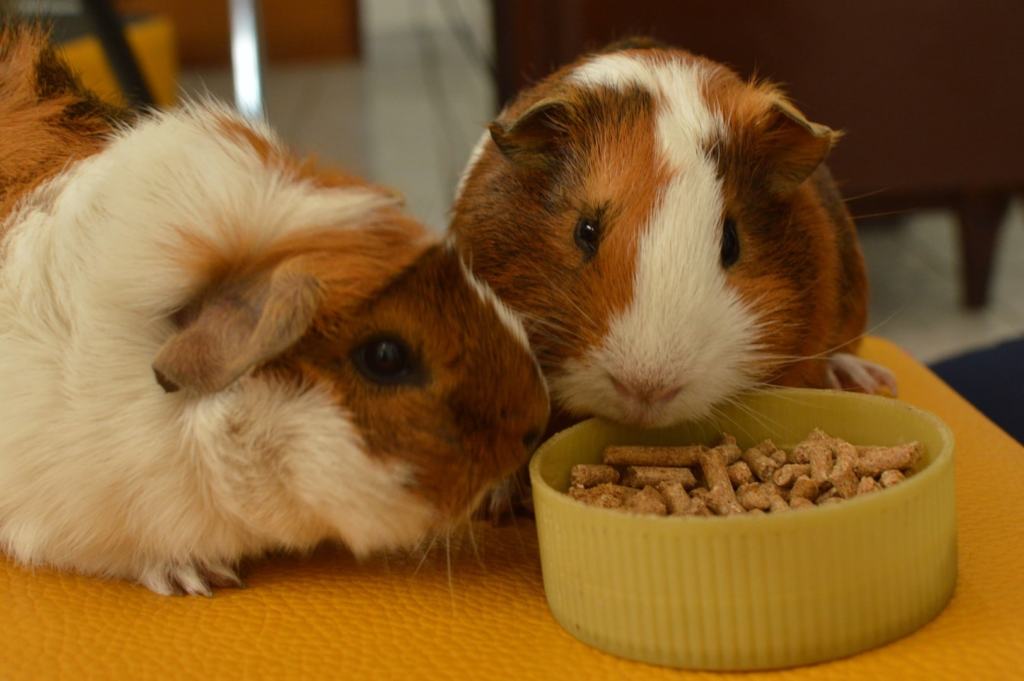Last Updated on December 28, 2023 by Fumipets
You may not be aware, but guinea pigs have been given the wrong names. First of all, they don’t originate in New Guinea; rather, the Andes Mountains of Peru are where they first appeared. And secondly, they have no connection to pigs whatsoever. They are thought to have been given the name “pig” because of the adorable squealing sound they make, which is somewhat piglike.
Like with any pet, your guinea pig’s food is extremely important. Make sure you’re giving your cavy everything he needs to eat each day and that you’re not giving him anything unhealthy.
So that you can give your pet the best diet possible, let’s look at everything there is to know about guinea pig diets. All of us want our cavies to thrive.
What to Feed Guinea Pigs
We’ll go over the many things that your guinea pig can and cannot consume. Hay is the most crucial component of the cavie diet. In fact, Timothy hay is often optimal and should make up 80% of guinea pig diet.
10%–15% of their food is made up of vegetables and herbs, and 5%–10% of it is pellets. And a treat is tossed in sometimes.Vegetables High in Vitamin C for Guinea Pigs
- Lettuce
- Spinach
- Tomatoes (no stems or leaves)
- Carrots (including the leafy tops)
- Parsley
- Parsnip
- All bell peppers
- Cucumber
- Zucchini
- Broccoli (small amounts or they might become gassy)
- Celery leaves
- Kale
- Cilantro/coriander
- Mustard greens
The veggies listed above are rich in vitamin C, which is crucial for guinea pigs. Each guinea pig should get daily access to around 1 cup of fresh veggies from this list. Image Source:
Vegetables that are acceptable for guinea pigs to consume but have lower vitamin C contents are listed below:
Vegetables Low in Vitamin C for Guinea Pigs
- Celery
- Mint
- Basil
- Dill
- Thyme
- Chicory
- Endive
- All lettuce (except for iceberg)
- Yams
- Carrots
- Asparagus
- Beansprouts
- Raw corn
- Radishes
- Turnips
- Beets
- Pumpkin
These vegetables should only be served once or twice a week because they don’t contain as much vitamin C.

Fruit High in Vitamin C for Guinea Pigs
- Kiwi
- Grapes
- Oranges/tangerines
- Strawberries
- Pomelo
- Pineapple
- Mango
- Guava
The fruits on this list are all healthy for your guinea pig since they are high in vitamin C, but because they are also heavy in sugar (even natural sugar), they should only be consumed seldom, if at all.
Fruit Low in Vitamin C for Guinea Pigs
- Apples
- Apricots
- Peaches
- Pears
- Plums
- Passion Fruit
- Cherries
- Watermelon
- Bananas
- Raspberries
- Blueberries
- Blackberries
Again, limit the fruit to infrequent treats a few times a week, such as a few blueberries or thin slices of apple, banana, or oranges, similar to how you would with low-vitamin C vegetables.Image: Natalya Matyushina, Shutterstock
Food Not Good for Guinea Pigs
- Grains
- Meat
- Dried beans
- Peas
- Seeds
- Nuts
- Chili peppers
- Lilies
- Buttercups
- Shrubs such as privet or hemlock
- Mushrooms
- Potatoes
- Garlic
- Onions
- Peanut butter
- Avocado
- Daffodils
- Rhubarb leaves
- Foxglove
- Human food (such as dairy, chocolate, crackers, bread, pasta, cereal, and anything with added sugar)
It should be clear why many of these things are bad for guinea pigs. Any item that may give your cavy gas, including cauliflower and cabbage, should be avoided.
Garlic is poisonous, onions (and anything from the onion family) can induce a blood disease, iceberg lettuce can cause diarrhoea, and avocados are excessively heavy in fat.
Your guinea pig must be introduced to new foods very gradually in order to avoid becoming unwell. Always introduce new foods gradually, starting with modest portions and progressively increasing them over time since they need some time to get used to them.
How Much Water?
Water is vital for guinea pigs, just as it is for practically all other living things. Nothing—not vitamins, minerals, or supplements—should be added to the water. They should have access to fresh water around-the-clock in water bottles made specifically for rats.
This entails daily fresh water fill-ups and constant verification of the water bottle’s functionality and remaining capacity. If you find that your water bottle is frequently empty throughout the day, think about buying a larger bottle.

Guinea Pig Feeding Chart
| Guinea Pig Feeding Schedule | Food |
| Monday | |
| *with fresh water, hay, and pellets | Broccoli |
| Cucumber | |
| Parsley | |
| Lettuce mix | |
| Fruit Day! | |
| Tuesday | |
| *with fresh water, hay, and pellets | Red pepper |
| Carrots | |
| Coriander | |
| Lettuce mix (try endive!) | |
| Wednesday | |
| *with fresh water, hay, and pellets | Parsnip |
| Celery | |
| Parsley | |
| Lettuce mix | |
| Fruit Day! | |
| Thursday | |
| *with fresh water, hay, and pellets | Zucchini |
| Cucumber | |
| Broccoli | |
| Lettuce mix (try radicchio!) | |
| Friday | |
| *with fresh water, hay, and pellets | Green pepper |
| Carrots | |
| Coriander | |
| Lettuce mix | |
| Saturday | |
| *with fresh water, hay, and pellets | Tomatoes |
| Cucumber | |
| Parsley | |
| Lettuce mix | |
| Fruit Day! | |
| Sunday | |
| *with fresh water, hay, and pellets | Celery |
| Carrots | |
| Coriander | |
| Lettuce mix |
This plan is only an illustration of possible weekly meals for your cavy. You can alter and modify as necessary by utilizing the lists above.Image Credit By: furbymama, pixabay
When to Feed Guinea Pigs
Timothy hay should always be accessible since it is a crucial component of the guinea pig’s diet.
Feeding your cavy twice a day is a good idea in addition to providing hay. To aid in preventing binge eating and, as a result, obesity, do so both in the morning and at night. After your cavy has eaten, always remove any uneaten pellets around an hour later, as well as any fruit or vegetables after 24 hours.
This applies to any hay as well; always get rid of the old before getting new.Timothy hay should always be accessible since it is a crucial component of the guinea pig’s diet.
Feeding your cavy twice a day is a good idea in addition to providing hay. To aid in preventing binge eating and, as a result, obesity, do so both in the morning and at night. After your cavy has eaten, always remove any uneaten pellets around an hour later, as well as any fruit or vegetables after 24 hours.
This applies to any hay as well; always get rid of the old before getting new.
Is Vitamin C Good for Your Guinea Pig?
For your cavy, vitamin C is highly necessary! Guinea pigs, like humans, are unable to synthesize vitamin C on their own, thus it’s essential to supplement their food with vitamin C. Guinea pigs are vulnerable to scurvy if they lack this essential vitamin.
Signs of vitamin C deficiency include:
- Diarrhea
- Weight loss
- Hair loss and skin problems
- Sneezing
- Crusty eyes
- Difficulty walking
- Swollen joints and feet
- Ulcers on skin or gums
If you see any of these signs, you should take your cavy to the veterinarian.
Although there are supplements you may give your guinea pig, a healthy diet that includes fruit and vegetables high in vitamin C should be plenty.

How to Choose Nutritious Supplements for Your Guinea Pig
Of course, you’ll want to provide your guinea pig high-quality food to keep him in good health. Because grass hay is the majority of your cavy’s diet, you should look for high-quality varieties. It is preferable to use timothy hay, which should be fragrant, fresh, green, and free of dust.
Choose uniform pellets over mixed-base diets and ensure that any commercially produced food is free of refined sugars. Uniform pellets are those that are all the same and are not mixed. A supplement that will give your cavy chelated minerals, prebiotics, and natural preservatives should be on your radar as well.
What Are the Best Natural Treats for Guinea Pigs?
As long as they are on the safe list, the finest treats for your guinea pig can be as straightforward as giving him a little bit of uncommon fruits or veggies. You may even decide to turn their usual diet into a game by, for example, placing some new hay into a cardboard tube (that they can fit into, of course).
While you could buy your cavy some commercial goodies, doing so is unnecessary since he would be delighted by a blueberry or slice of carrot.
If your guinea pig is eating this treat for the first time, don’t forget to start with a small quantity. You don’t want your cavy to be uncomfortable.
What to Do if Your Guinea Pig Isn’t Eating
Your guinea pig may not be eating for a variety of reasons, such as stress or sickness. A person may lose their appetite for any number of reasons, including dental problems, dietary changes, and even environmental changes.
Take your guinea pig to the veterinarian as soon as you can if you’ve observed any of these signs:
- Lethargy
- Depression
- Weight loss
- Lessening of elasticity in his skin
- Water and food untouched
- Rough hair
- Fever and diarrhea (could indicate an infection)
The most common causes for a loss of appetite can include:
- Not enough fresh water
- Recent surgery
- Stress
- Changes in the diet
- Changes in the environment
- Underbite or overbite of teeth
- Infection
- Too hot or too cold in the environment (optimal is 65-75°F)
- Ketosis of the liver
Simply make sure your pet is comfortable if the only sign he exhibits is a loss of appetite. Maintain a clean enclosure for him and provide him a healthy, balanced feed while keeping an eye on the temperature and removing any potential sources of stress. Take him to the vet if you think there could be more going on.
Conclusion
Your pet’s nutrition is a crucial component of maintaining his wellbeing. You may create your own special and customized diet that will fit your cavy’s preferences as long as you do your research and comprehend which foods are healthy for your guinea pig and which foods you should avoid. All of us desire a happy and long life for our pets.
https://www.youtube.com/watch?v=u2ocfMKB30s

![Guinea Pig Diet; How Much, and How Often [Feeding Chart & Guide] Guinea Pig Diet; How Much, and How Often [Feeding Chart & Guide]](https://fumipets.com/wp-content/uploads/2022/09/Guinea-Pig-Diet-How-Much-and-How-Often-Feeding-Chart-Guide.jpg)
















